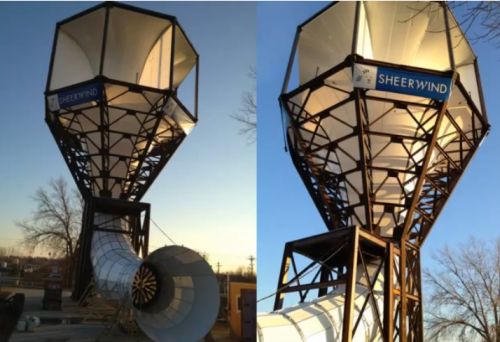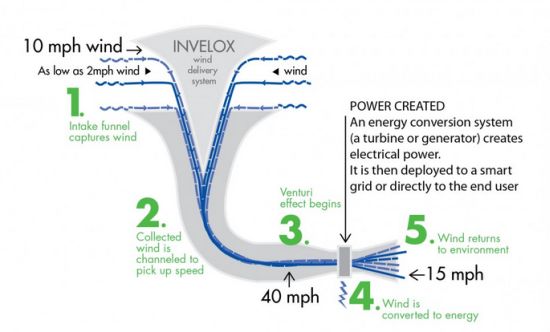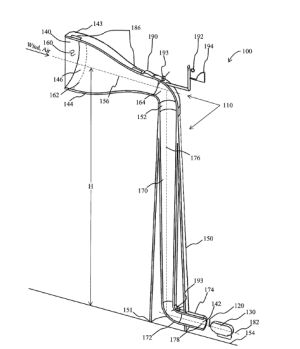Many inventors have questioned the logic of harnessing wind power by situating heavy gearboxes, generators, and rotor blades hundreds of feet in the air, as is the case for conventional horizontal wind turbines. One alternative design that does away with all these entities looks as though it is getting traction from both investors and a few potential customers.
SheerWind in Chaska, Minn., has fielded a wind power idea based on the Venturi effect. Basically it collects wind and compresses it in a funnel-like chamber before sending it to turn the blades of a generator. The generator sits on the ground rather than at the top of a tower. The brain child of Dr. Daryoush Allaei, a mechanical engineer, the wind catcher is called the Invelox. A 90-foot-tall version of the device, says Allaei, could create the same amount of power as a 1.8-MW commercial wind tower. But it would be a third of the height, sit on a seventh of the land, and use turbine blades eight times smaller in diameter than what you'd find on a utility scale turbine. Allaei also claims the electricity would be at least 40% cheaper to produce.
 Visible
in these images of the Invelox are the input baffles (top) and
generator (bottom).One benefit of Allaei's design
is that it will work with breezes of only two miles per hour,
compared to the 8 mph or more it takes to start a conventional
turbine. The operating is similar to that of hydroelectric dams,
Allaei points out, but with water replaced by air. Another
benefit is that the materials used to funnel and concentrate the
air can be inexpensive. One of Allaei's ideas is to produce a
collapsible aluminum-and-fabric version that could be
air-dropped and assembled at military outposts or in disaster
areas. Invelox wind catchers could also be built as part of
commercial buildings, with ducts installed the same way as HVAC
ducting is now, he says.
Visible
in these images of the Invelox are the input baffles (top) and
generator (bottom).One benefit of Allaei's design
is that it will work with breezes of only two miles per hour,
compared to the 8 mph or more it takes to start a conventional
turbine. The operating is similar to that of hydroelectric dams,
Allaei points out, but with water replaced by air. Another
benefit is that the materials used to funnel and concentrate the
air can be inexpensive. One of Allaei's ideas is to produce a
collapsible aluminum-and-fabric version that could be
air-dropped and assembled at military outposts or in disaster
areas. Invelox wind catchers could also be built as part of
commercial buildings, with ducts installed the same way as HVAC
ducting is now, he says.
The city of Royalton, Minn., is said to be evaluating the Invelox design for possible installation there.
 Operating
principles of the Invelox.All in all, Allaei
figures the design can generate power at a cost of 2.8 to
4.1¢/kWh, competitive even with natural gas. The company has
spent the past year validating the design by such means as using
conservation of mass, conservation of energy, and Bernoulli
equations applicable to pipe carrying flow. They've also
produced full scale computational fluid dynamic (CFD) models of
the design that were used to investigate and develop design
trade secrets to design and produce demonstration units.
Operating
principles of the Invelox.All in all, Allaei
figures the design can generate power at a cost of 2.8 to
4.1¢/kWh, competitive even with natural gas. The company has
spent the past year validating the design by such means as using
conservation of mass, conservation of energy, and Bernoulli
equations applicable to pipe carrying flow. They've also
produced full scale computational fluid dynamic (CFD) models of
the design that were used to investigate and develop design
trade secrets to design and produce demonstration units.
Allaei's wind catcher concept as he described it in one of his patents.
